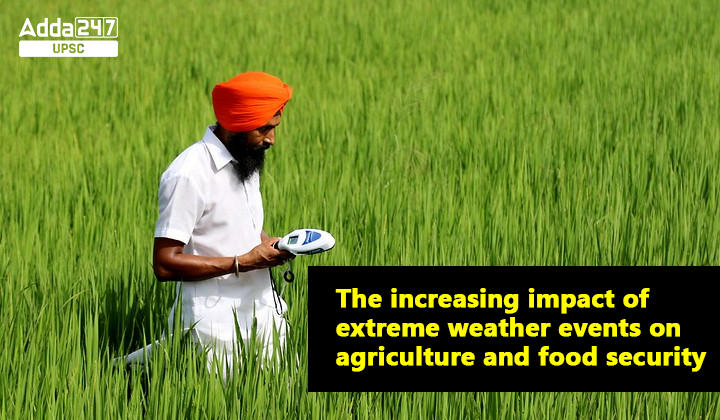Table of Contents
In recent years, the world has witnessed a worrying trend in the increasing frequency and severity of extreme events, impacting both human lives and the global economy. Over the past three decades, losses from these events have reached an alarming $3.8 trillion, an average of about $123 billion per year. This article highlights the implications of this increase, focusing on its devastating impact on agriculture and food security.
Rising wave of Disaster Events
The increase in disaster events is one of the defining characteristics of our era. The numbers are staggering: during the 1970s, there were approximately 100 disaster events per year. Fast forward to the last two decades, and this figure has quadrupled to 400 disaster events annually. This growing trend is not only worrying but also threatens the foundation of food security at the global level.
Sensitive Climate and Unprecedented Events
The year 2023 marks the culmination of the hottest decade on record, which has brought with it a series of unprecedented extreme weather events and large-scale disasters. What makes these disasters even more devastating is the combination of climate change, ongoing conflict, and the lingering COVID-19 pandemic. These interconnected factors create a perfect storm of insecurity, particularly for agriculture and food security.
Impact on Agriculture and Food Security
Agricultural activities and livelihoods are intricately linked to environmental conditions, natural resources, and ecosystems. As extreme events become more frequent and severe, the agricultural sector faces increasing threats such as floods, water scarcity, drought, and environmental degradation. These challenges are not limited to any one area; they are global in scale. For example, in Pakistan, exceptional monsoon rains in 2022 caused losses to the agricultural sector of about $4 billion. In the US, crop and rangeland losses were estimated at more than $21.4 billion in 2022 by the National Oceanic and Atmospheric Administration.
Disproportionate Impact on Agriculture
Data from 88 post-disaster needs assessments (PDNAs) conducted in 60 countries from 2007 to 2022 showed that agricultural losses accounted for an average of 23% of the total impact of disasters across all regions. This statistic is particularly worrying as it emphasizes the enormous burden that extreme events place on agriculture.
However, it is important to note that the available data focuses primarily on low-income countries and major extreme events. A comprehensive global estimate of economic losses across all regions remains elusive.
Types of Extreme events and their impact
The PDNA also revealed the different impacts of different types of extreme events on agriculture. More than 65% of losses due to drought affected the agricultural sector, while floods, storms, cyclones and volcanic activity each caused about 20% of losses. This information underscores the need for systematic data collection and reporting to address these disparities.
The report used secondary data sources such as EM-DAT and FAOSTAT production data to measure the impact of disasters on agriculture, particularly focusing on crop and livestock production. The findings show that estimated losses in these sub-sectors have been gradually increasing over the past three decades.
Increasing losses in crop and livestock production
Over the past three decades, losses in major crop and livestock product groups have seen a steady increase. Annual losses of grains averaged 69 million tons, while losses of fruits, vegetables, and sugar crops averaged 40 million tons each year.
An estimated 16 million metric tons of meat, dairy products, and eggs were lost annually. These statistics highlight the need for comprehensive strategies to reduce these losses and ensure global food security.
Regional disparities in deficits
The distribution of total losses across regions from 1991 to 2021 reflects the size and geographic vulnerabilities of each region. Asia suffered the largest share of the economic loss at 45%, while Africa, Europe, and the Americas exhibited similar magnitudes. Oceania, on the other hand, suffered the lowest total losses.
However, economic disparities between countries tell a different story. High-income countries, lower-middle-income countries, and upper-middle-income countries reported higher losses in absolute terms, while low-income countries and small island developing states experienced lower levels.
When considering losses relative to agricultural value added, low-income countries suffered on average more than twice as much as upper-middle-income countries.
Need for a comprehensive approach
The increasing impact of extreme events on agriculture and food security is a global concern requiring a comprehensive approach. This approach should include international cooperation to build resilience, share best practices, and provide assistance to the most vulnerable sectors.
Additionally, it is important to invest in climate-smart agricultural practices, early warning systems, and disaster risk reduction to reduce losses to agriculture and food security.
Conclusion
In conclusion, the increasing frequency and severity of extreme events is an important threat to agriculture and food security globally. Creates complete danger. The $3.8 trillion deficit over the past 31 years is a stark reminder of the need for urgent action.
Addressing this issue requires a multi-pronged strategy that includes not only mitigating the impacts of climate change but also building the resilience of vulnerable communities and nations. Only through collective efforts can we hope to secure a sustainable and food-secure future for all.



 TSPSC Group 1 Question Paper 2024, Downl...
TSPSC Group 1 Question Paper 2024, Downl...
 TSPSC Group 1 Answer key 2024 Out, Downl...
TSPSC Group 1 Answer key 2024 Out, Downl...
 UPSC Prelims 2024 Question Paper, Downlo...
UPSC Prelims 2024 Question Paper, Downlo...
